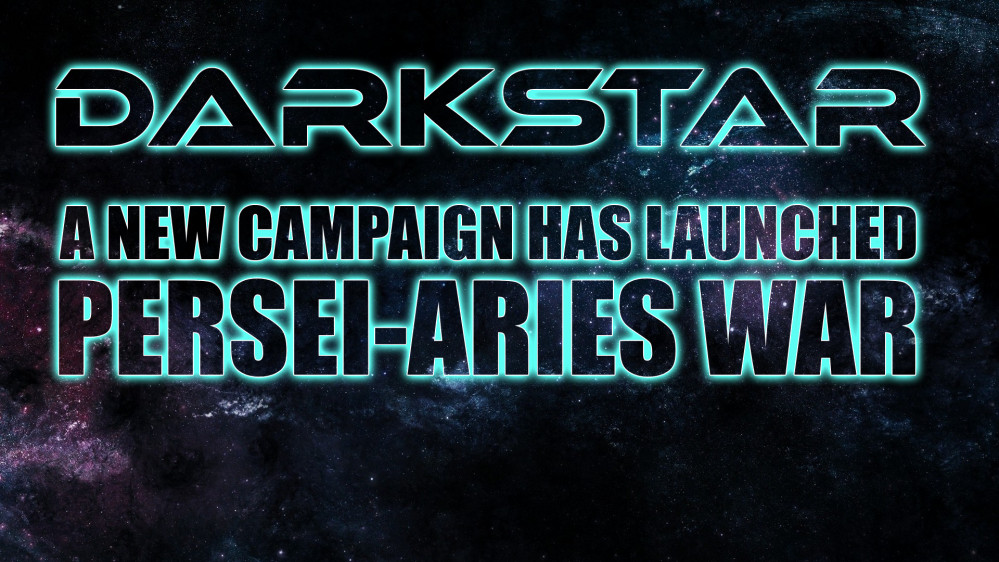
Persei-Aries War Resumes
British vs. French in All-Out Cruiser Melee!
Earlier this week, my friend Elessar2590 and I sat down for a long-overdue game of Darkstar … and a pretty big one as well. With eleven total warships (not including 30+ aerospace craft) and 438 points, this game wound up taking about 5 ½ hours to play out, but it had a great finish.
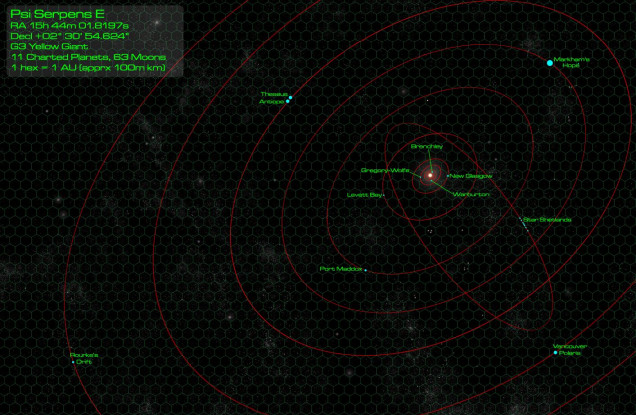 Elessar2590 wanted to play his British task force. For an opposing force, I decided there was no better foe for a classic Napoleonic-themed British fleet than the French. So I brought in a mixed “New Roman” force of my French, bulked out by an “NPC” Italian heavy cruiser of the Tiberius class. The last time the British and New Romans (a coalition of Italian, French, Spanish, Swiss, and other powers) really went to the mat in 400+ point games was in the Psi Serpentis War, so I decided to set this one-off game during that period. The setting was thus chosen as the “Markham’s Hope” colonies in Psi Serpens E (New Glasgow) star system, with a Franco-Italian raid on this huge British gas giant – more specifically, on the colonies built on one of the planet’s Galilean moons (Markham 12).
Elessar2590 wanted to play his British task force. For an opposing force, I decided there was no better foe for a classic Napoleonic-themed British fleet than the French. So I brought in a mixed “New Roman” force of my French, bulked out by an “NPC” Italian heavy cruiser of the Tiberius class. The last time the British and New Romans (a coalition of Italian, French, Spanish, Swiss, and other powers) really went to the mat in 400+ point games was in the Psi Serpentis War, so I decided to set this one-off game during that period. The setting was thus chosen as the “Markham’s Hope” colonies in Psi Serpens E (New Glasgow) star system, with a Franco-Italian raid on this huge British gas giant – more specifically, on the colonies built on one of the planet’s Galilean moons (Markham 12).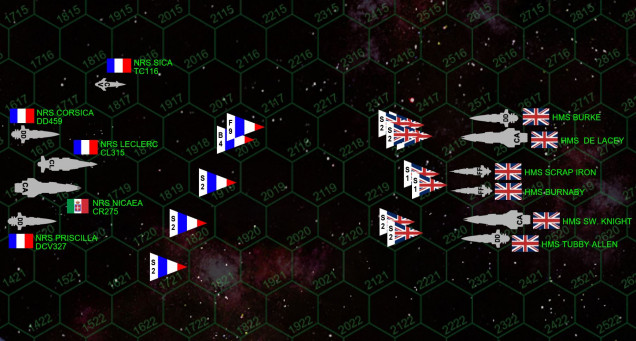 Elessar2590 has recently expanded his task force to include two Iron Duke class heavy cruisers, two Falklands class destroyers, and two Cornwallis class frigates. Some of these ships had campaign upgrades, so his fleet wound up tipping the scales at 438 points. To match him, I set up my “NPC” Tiberius class heavy cruiser, along with my “campaign commanders” I’ve been building up off and on for the past few years. Overall, the French fleet is MUCH lighter, but also faster, more maneuverable (I’ll almost always win initiative), and has aerospace support in the form of the light carrier NRS Priscilla. Also, my French light cruiser NRS Leclerc (Foch-Hispaniola class) is far deadlier than she looks and can punch far above her weight class due to her upgrades. Still, the British have TWO heavy cruisers to my one …
Elessar2590 has recently expanded his task force to include two Iron Duke class heavy cruisers, two Falklands class destroyers, and two Cornwallis class frigates. Some of these ships had campaign upgrades, so his fleet wound up tipping the scales at 438 points. To match him, I set up my “NPC” Tiberius class heavy cruiser, along with my “campaign commanders” I’ve been building up off and on for the past few years. Overall, the French fleet is MUCH lighter, but also faster, more maneuverable (I’ll almost always win initiative), and has aerospace support in the form of the light carrier NRS Priscilla. Also, my French light cruiser NRS Leclerc (Foch-Hispaniola class) is far deadlier than she looks and can punch far above her weight class due to her upgrades. Still, the British have TWO heavy cruisers to my one …  The engagement begins above the dawn terminator of the Galilean moon Markham’s Hope-12, with the HMS Swedish Knight leading the British task force past the rubble of mined asteroids (gravity-tugged into orbit of the Markham’s Hope 12 colony). The New Romans cut in as well, both task forces doing about 30 kps, the Romans cutting a port turn around another captured asteroid. The new Romans can’t QUITE get the British into their broadside, no both sides open fire with long-range forward batteries at ranges of about 4000 kilometers (hexes are 180 kilometers across, turn is 1 minute, each point of movement = 3 kilometers a second). The French light carrier NRS Priscilla starts launching her aerospace group, leading off with Caproni CA.580 “Aquila” (Eagle) bombers.
The engagement begins above the dawn terminator of the Galilean moon Markham’s Hope-12, with the HMS Swedish Knight leading the British task force past the rubble of mined asteroids (gravity-tugged into orbit of the Markham’s Hope 12 colony). The New Romans cut in as well, both task forces doing about 30 kps, the Romans cutting a port turn around another captured asteroid. The new Romans can’t QUITE get the British into their broadside, no both sides open fire with long-range forward batteries at ranges of about 4000 kilometers (hexes are 180 kilometers across, turn is 1 minute, each point of movement = 3 kilometers a second). The French light carrier NRS Priscilla starts launching her aerospace group, leading off with Caproni CA.580 “Aquila” (Eagle) bombers.  The Swedish Knight starts a turn to starboard, clearly trying to get the Romans in her powerful broadside of 10-gigawatt railguns. The Italian flagship, NRS Nicaea, sees the move and accelerates in a hard starboard turn, cutting half-behind the Swedish Knight. Both heavy cruisers have each other in broadside, but the Romans will be hitting the Swedish Knight’s port QUARTER (engines and reactors), while the British will be hitting Nicaea’s port BOW (less vulnerable systems). Also, the Franco-Italians are clearly trying to cut behind the British for broadsides and torpedo strikes on British sterns. The fight quickly devolves into a melee, with the cruiser De Lacey turning directly FOR the Nicaea, the Priscilla’s aerospace group of “Aquila” bombers and Dassault-Rafael “Mirage XII” Fighters joining the torpedo strike of the corvette Sica (Drusus class) against the stern of the Burke. Mass British torpedoes also strike the Nicaea, but both ships weather the storm (somewhat) thanks to small-caliber mass driver support from nearby friendly warships.
The Swedish Knight starts a turn to starboard, clearly trying to get the Romans in her powerful broadside of 10-gigawatt railguns. The Italian flagship, NRS Nicaea, sees the move and accelerates in a hard starboard turn, cutting half-behind the Swedish Knight. Both heavy cruisers have each other in broadside, but the Romans will be hitting the Swedish Knight’s port QUARTER (engines and reactors), while the British will be hitting Nicaea’s port BOW (less vulnerable systems). Also, the Franco-Italians are clearly trying to cut behind the British for broadsides and torpedo strikes on British sterns. The fight quickly devolves into a melee, with the cruiser De Lacey turning directly FOR the Nicaea, the Priscilla’s aerospace group of “Aquila” bombers and Dassault-Rafael “Mirage XII” Fighters joining the torpedo strike of the corvette Sica (Drusus class) against the stern of the Burke. Mass British torpedoes also strike the Nicaea, but both ships weather the storm (somewhat) thanks to small-caliber mass driver support from nearby friendly warships.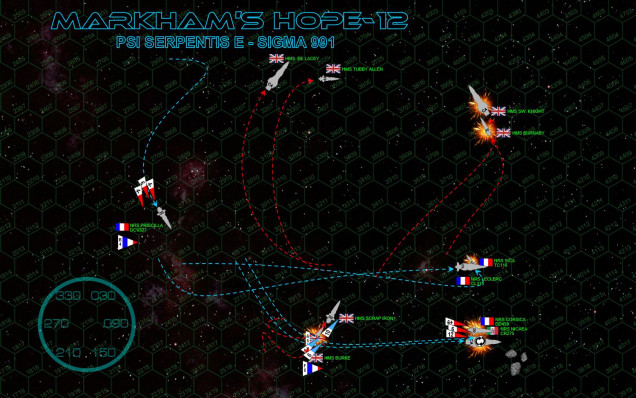 By this point in the engagement, many ships on both sides have absorbed tremendous punishment but so far all remain operational. However, as ranges continue to close and captains vie for gunnery positions … and FURTHER torpedo strikes hiss toward their targets … this all changes with horrific speed. “Aquila” fighters launch a daring strafing attack on the ravaged stern of the HMS Burke, which she survives, putting a broadside into the stern of the French destroyer NRS Corsica, who’s 8 megakelvin lasers have just sliced through the reactors of the frigate HMS Burnaby. French torpedoes (Dassault-Rafale "Lancea" Class IVs) streak in after the fighters, and Burke’s engineering section is blown apart. More torpedoes come in after the HMS Scrap Iron, but she shoots down enough torpedoes to survive the attack, adding a further fusillade at 1000 kilometers into the stern of the Corsica, burning the engines out of the hull and leaving her adrift as well. The heavy cruiser Swedish Knight hammers on the corvette Sica, quickly shutting her down as well with a laser through the bridge. Only the quick thinking and bravery of the skipper, Lt. Commander Sebastian Anjou, saves the ship to be salvaged later … but Anjou himself will sadly die of his wounds. The Nicaea takes bloody revenge, absolutely shearing the stern all but clean off the Swedish Knight, instants before a massed British torpedo strike smashes through her engineering sections as well. In sixty seconds, six warships totaling 450,000 tons of shipping, have been knocked out of the battle.
By this point in the engagement, many ships on both sides have absorbed tremendous punishment but so far all remain operational. However, as ranges continue to close and captains vie for gunnery positions … and FURTHER torpedo strikes hiss toward their targets … this all changes with horrific speed. “Aquila” fighters launch a daring strafing attack on the ravaged stern of the HMS Burke, which she survives, putting a broadside into the stern of the French destroyer NRS Corsica, who’s 8 megakelvin lasers have just sliced through the reactors of the frigate HMS Burnaby. French torpedoes (Dassault-Rafale "Lancea" Class IVs) streak in after the fighters, and Burke’s engineering section is blown apart. More torpedoes come in after the HMS Scrap Iron, but she shoots down enough torpedoes to survive the attack, adding a further fusillade at 1000 kilometers into the stern of the Corsica, burning the engines out of the hull and leaving her adrift as well. The heavy cruiser Swedish Knight hammers on the corvette Sica, quickly shutting her down as well with a laser through the bridge. Only the quick thinking and bravery of the skipper, Lt. Commander Sebastian Anjou, saves the ship to be salvaged later … but Anjou himself will sadly die of his wounds. The Nicaea takes bloody revenge, absolutely shearing the stern all but clean off the Swedish Knight, instants before a massed British torpedo strike smashes through her engineering sections as well. In sixty seconds, six warships totaling 450,000 tons of shipping, have been knocked out of the battle. 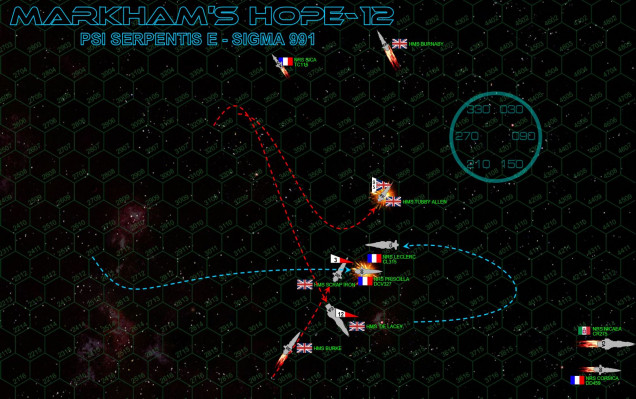 On the bridge of the cruiser De Lacey, Edward Evans assumes command of what’s left of the British task force, kicking his grav rudder hard to starboard and closing with the French while also trying to consolidate his fleet. The skipper of the frigate Tubby Allen is caught out of position however, as the ruthless Captain Ralphael deChalemonde assumes command aboard the Leclerc, and cuts his swift, sleek cruiser between the Allen and the De Lacey. His aft guns cripple the Tubby Allen with almost contemptuous ease, his forward guns raking the starboard bow of the HMS Scrap Iron, destroying both hangers, damaging the bridge, and JUST missing the magazine. The Scrap Iron, however, takes a grim revenge, point-blank opening fire into the stern of the French carrier NRS Priscilla. The Priscilla has closed to this distance for protection from British torpedoes, a tactic that works well enough … but its doesn’t save her from the lasers and syglex emitters of the Scrap Iron. Only by a VERY fast reaction of the ship’s engineer does NRS Priscilla eject her reactors in time, leaving the ship crippled but at least sparing her from a full-scale explosion. Ironically, post-battle analysis reveals that HAD NRS Priscilla exploded, she was close enough to HMS Scrap Iron to take her out as well with the blast wave … a “crash-down” emergency bulkhead is all that stands between the burning bridge’s starboard side and the raw vacuum of space.
On the bridge of the cruiser De Lacey, Edward Evans assumes command of what’s left of the British task force, kicking his grav rudder hard to starboard and closing with the French while also trying to consolidate his fleet. The skipper of the frigate Tubby Allen is caught out of position however, as the ruthless Captain Ralphael deChalemonde assumes command aboard the Leclerc, and cuts his swift, sleek cruiser between the Allen and the De Lacey. His aft guns cripple the Tubby Allen with almost contemptuous ease, his forward guns raking the starboard bow of the HMS Scrap Iron, destroying both hangers, damaging the bridge, and JUST missing the magazine. The Scrap Iron, however, takes a grim revenge, point-blank opening fire into the stern of the French carrier NRS Priscilla. The Priscilla has closed to this distance for protection from British torpedoes, a tactic that works well enough … but its doesn’t save her from the lasers and syglex emitters of the Scrap Iron. Only by a VERY fast reaction of the ship’s engineer does NRS Priscilla eject her reactors in time, leaving the ship crippled but at least sparing her from a full-scale explosion. Ironically, post-battle analysis reveals that HAD NRS Priscilla exploded, she was close enough to HMS Scrap Iron to take her out as well with the blast wave … a “crash-down” emergency bulkhead is all that stands between the burning bridge’s starboard side and the raw vacuum of space.  The NRS Leclerc is now badly hammered and venting into space as well, her port bow mauled by the 500-km broadside of HMS De Lacey. Now alone, deChalemonde knows he has to make a run for it. Ideally, he’d turn to starboard and escape over the moon’s north pole, but De Lacey’s 10-gigawatt rail guns have just torn one of her maneuvering thrusters out of Leclerc’s hull. This leaves deChalemonde with only one option … all ahead flank and simply race forward. The Leclerc is a very fast cruiser, and he ALMOST gets away with it, especially after Scrap Iron reverse-thrusts to a dead standstill in space and De Lacey is caught flatfooted after turning the other way. It’s not enough though. At a range of 3800 kilometers, DeLacey’s broadside is enough to cripple Leclerc’s engines and leave her crippled and adrift.
The NRS Leclerc is now badly hammered and venting into space as well, her port bow mauled by the 500-km broadside of HMS De Lacey. Now alone, deChalemonde knows he has to make a run for it. Ideally, he’d turn to starboard and escape over the moon’s north pole, but De Lacey’s 10-gigawatt rail guns have just torn one of her maneuvering thrusters out of Leclerc’s hull. This leaves deChalemonde with only one option … all ahead flank and simply race forward. The Leclerc is a very fast cruiser, and he ALMOST gets away with it, especially after Scrap Iron reverse-thrusts to a dead standstill in space and De Lacey is caught flatfooted after turning the other way. It’s not enough though. At a range of 3800 kilometers, DeLacey’s broadside is enough to cripple Leclerc’s engines and leave her crippled and adrift. 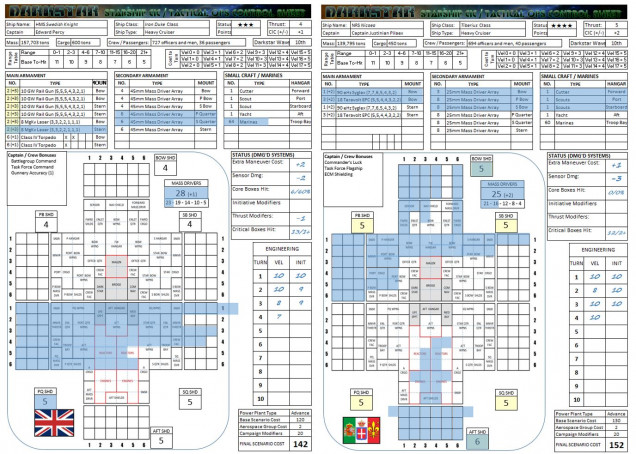 The battle was ALMOST a “major victory” for the British, with the French effectively being tabled here and only their aerospace group remaining. With the score being 418-245, the victory margin of 173 was calculated to be 39.4977% of the 438 beginning total … JUST short of the 39.5 … which would round up to 40 … the required percentage margin for a Major Victory. Still, it’s a SOLID win for sure, congrats to Elessar2590 for the great game!
The battle was ALMOST a “major victory” for the British, with the French effectively being tabled here and only their aerospace group remaining. With the score being 418-245, the victory margin of 173 was calculated to be 39.4977% of the 438 beginning total … JUST short of the 39.5 … which would round up to 40 … the required percentage margin for a Major Victory. Still, it’s a SOLID win for sure, congrats to Elessar2590 for the great game! 
































![TerrainFest 2024! Build Terrain With OnTableTop & Win A £300 Prize [Extended!]](https://images.beastsofwar.com/2024/10/TerrainFEST-2024-Social-Media-Post-Square-225-127.jpg)








































Excellent game, congratulations to all.
Thanks very much @gremlin !